Blog
August 6th, 2009
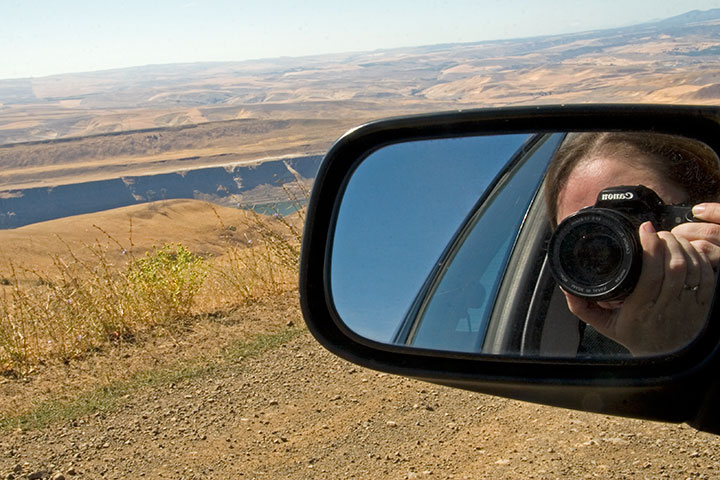
A year ago today our bright yellow moving truck pulled into Tacoma and turned the corner onto a new home, a new career, a new life. Here I am, 365 days later, and I’m still just as excited as on day one. To everyone in T-Town (and Seattle, and Portland, and everywhere in between!) who has welcomed me as one of your own: thank you, with everything I have.
I tend to be a list-maker, constantly looking ahead to what is yet to be done. And as I sifted through the thousands of photos I took over the past year, trying to narrow them down to a few favorites, a whole new to-do list emerged. Despite my best, most frantic efforts, I’ve barely scratched the surface of this new home of mine.

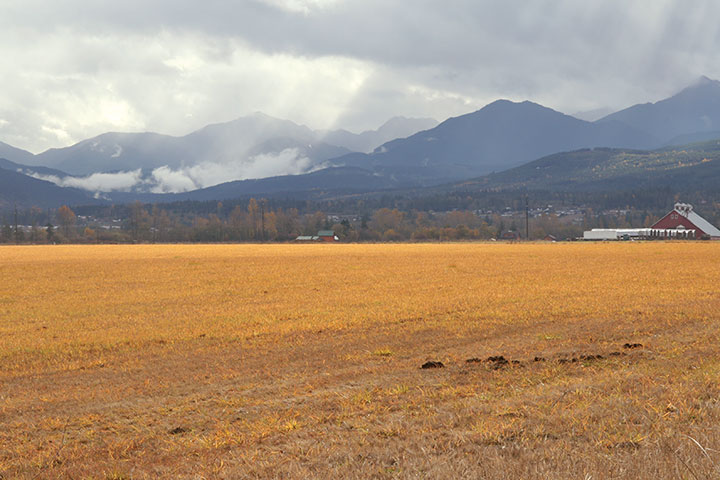

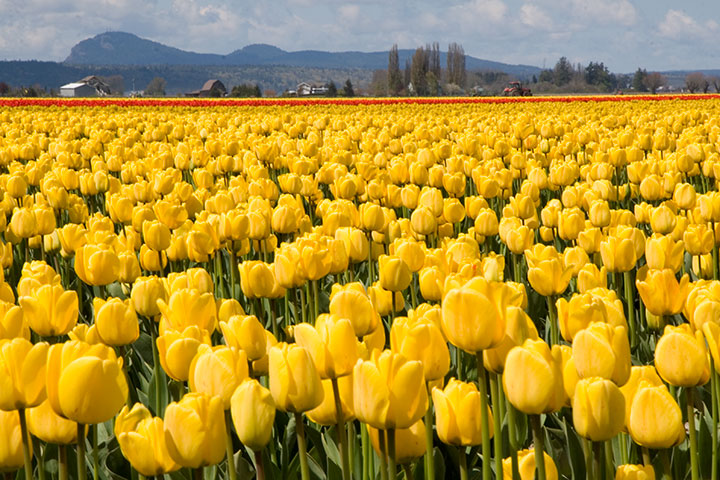
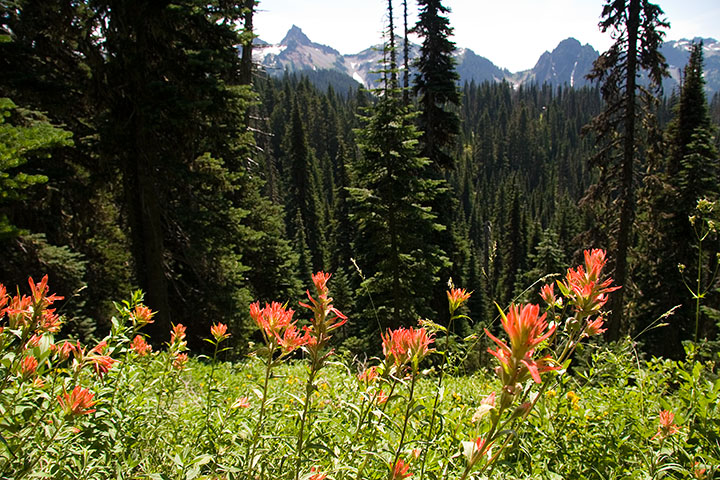
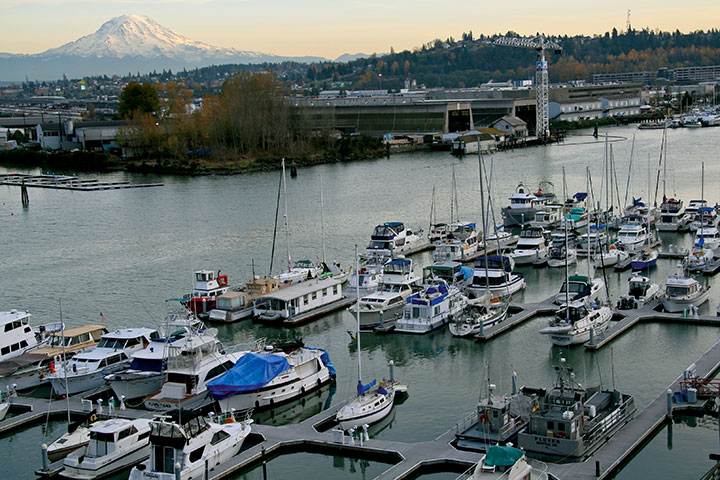
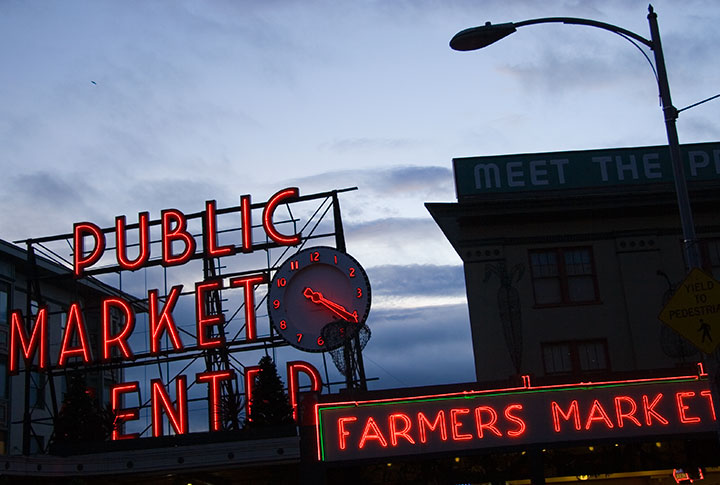
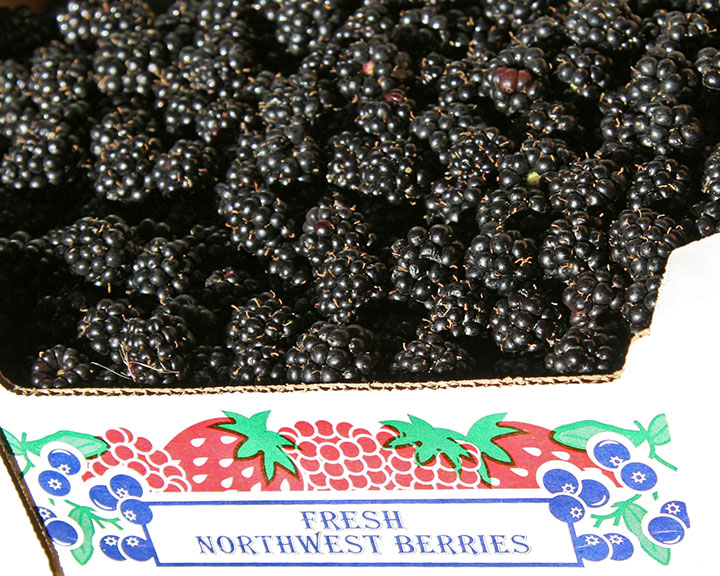
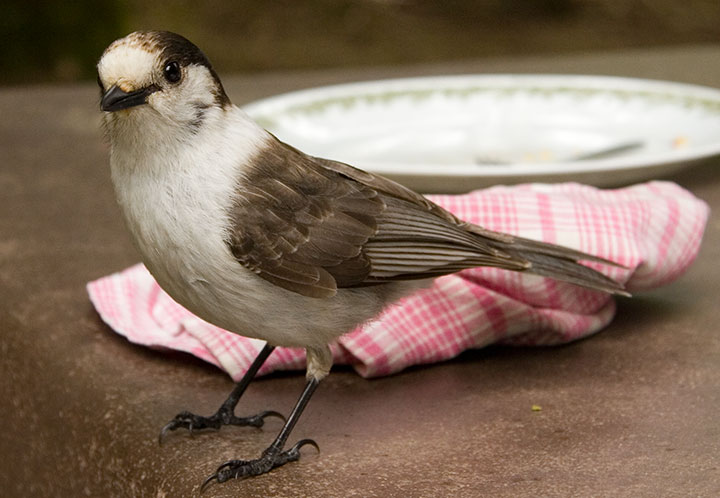
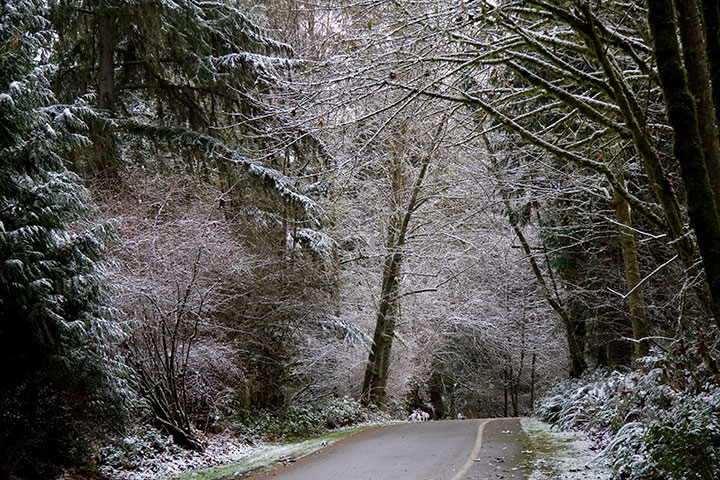
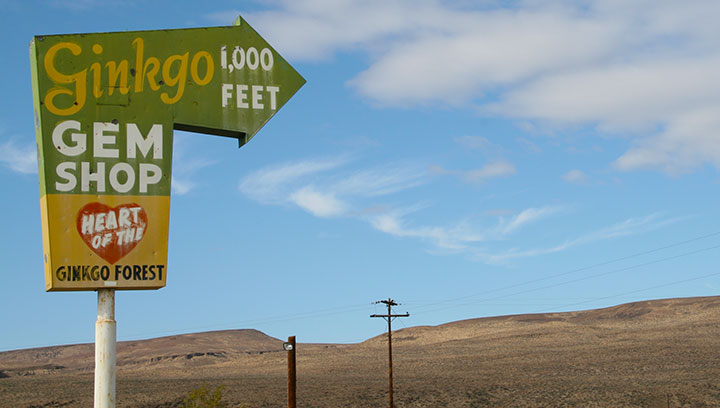
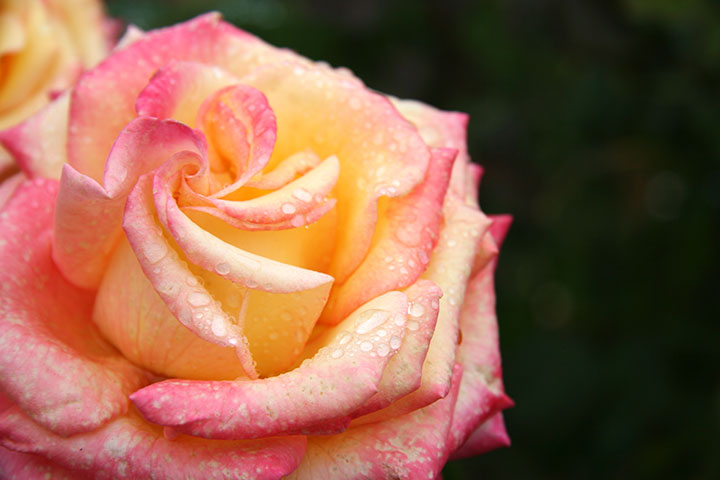
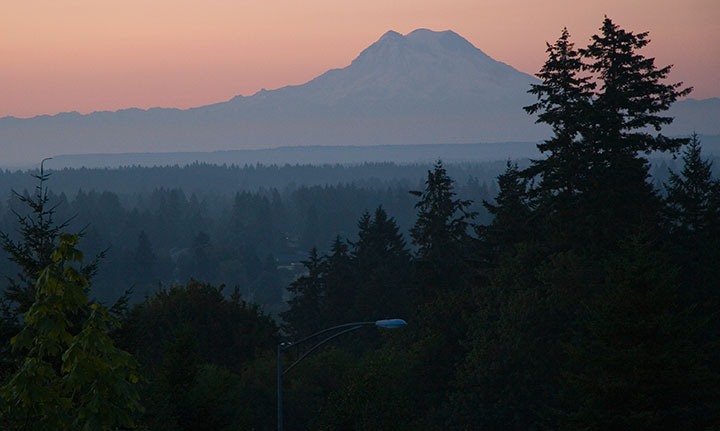
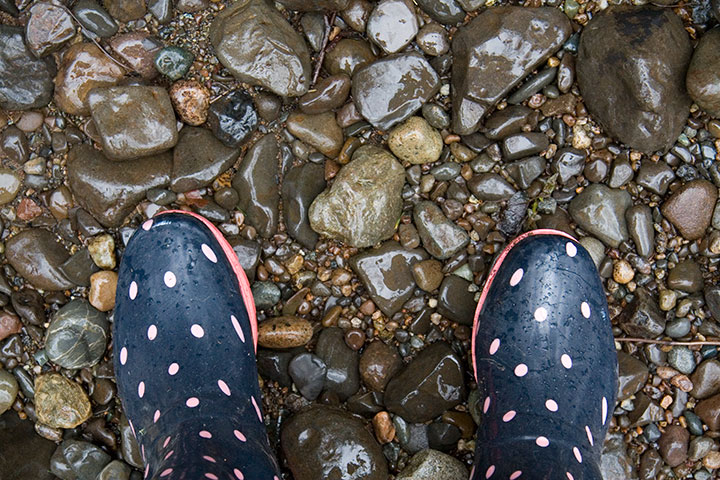
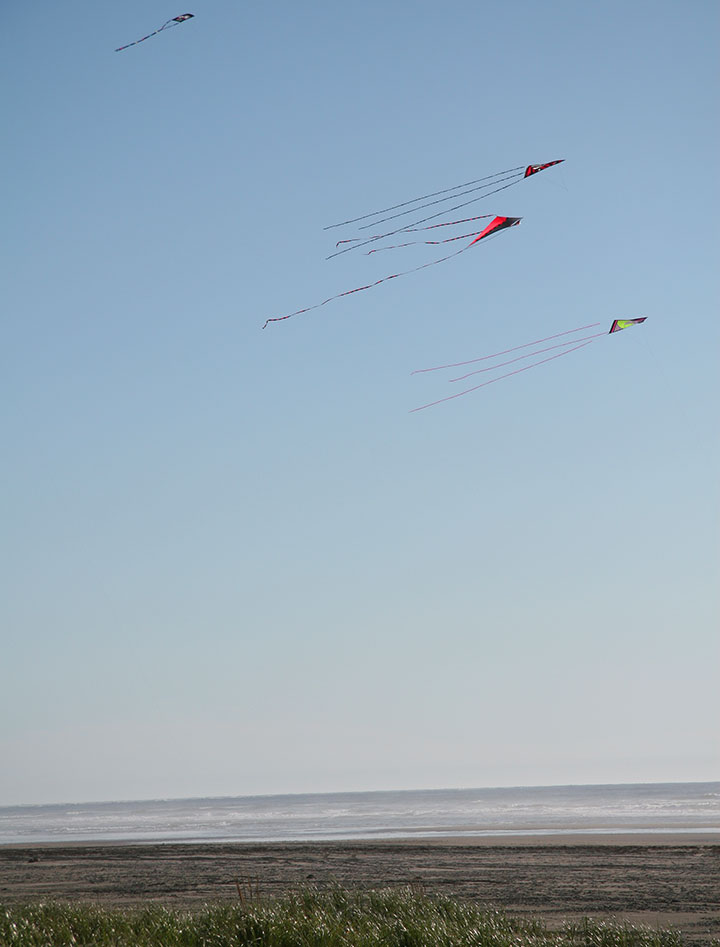
So I’ve got my work cut out for me. Washington, I’d like to get to know you a little better.
August 3rd, 2009
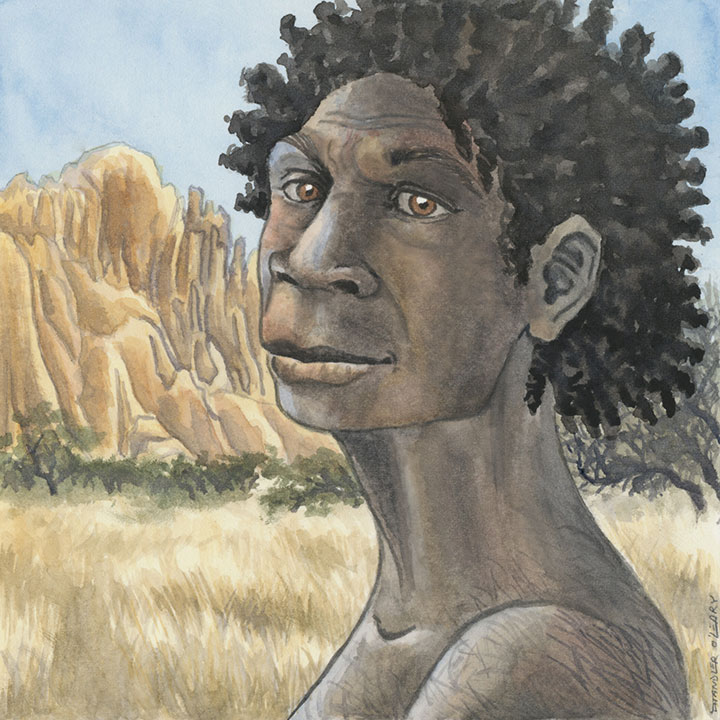
Lately I’ve been doing some things that fall a little outside of what you might normally find in my studio. See figure A, above. Daughter of Kura, the debut novel by Debra Austin, is being released tomorrow, so Debra and the folks at Side x Side Creative put together an in-depth website to promote the book and give background information about the book. They asked me to contribute some illustrations to the project. (Full disclosure: I’m not the book jacket illustrator. Edited to add: the above illustration did become the jacket illustration for the book’s sequel, Mother of Asili.)
This was no ordinary illustration gig; in fact, I’d say this project was one of the biggest creative challenges I’ve faced yet. You see, Daughter of Kura is a novel about a pre-human culture—not merely prehistoric, but pre- homo sapiens. The only reference materials available were the fossil record and educated conjecture. It took a lot of research on everybody’s part to bring all of this together, and we hope you’ll be as pleased with the final product as we are. You can learn more about the book and see all of the illustrations here.
July 29th, 2009
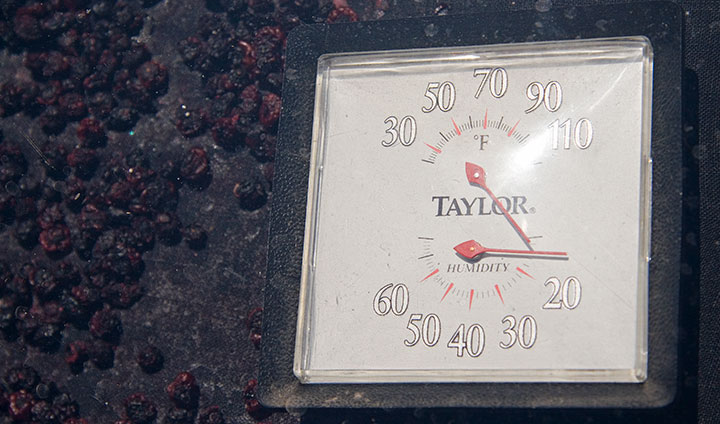
They’re predicting 105 degrees today here in T-town—that’s an all-time, record-breaking high. Now, if you’re in the Midwest, the South, or the Southwest and you’re reading this, you’re probably thinking, “And this is news how?” Well, this is where the part about “all-time” comes in—since white settlement of this area, at least, it has never, ever been this hot before. This place ain’t made for 105°. Almost nobody has air conditioning, but the discomfort is only the half of it. Who knows what this will mean for the snow pack in the mountains, or the water supply?
Beastly or not, though, it seemed a shame to let all this amazing solar energy go to waste. So over the weekend the Tailor devised a passive food dehydrator out of old window panes (buying an electric dryer, to us, seemed to defeat the purpose of home sustainability). Our first attempt at drying berries seemed successful, so at 5:30 this morning,before the heat kicked in, we headed to the Blueberry Park to pick about three gallons more. (The berries are happy with the heat, even if nobody else is!)

Here’s how it works: four nylon window screens (don’t use aluminum! It reacts with the food) hover over the pavement, propped up on wooden beams to allow for air circulation. Tied to each screen is a black linen cloth to absorb more heat and provide a clean surface for the food, while still letting air pass through. The glass windows fit right on top, providing the perfect space to trap hot air, just like a greenhouse.
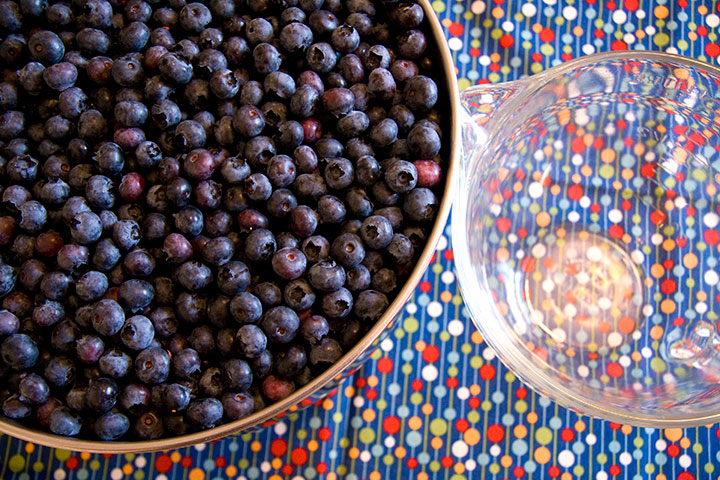
Now, on to the fruit itself. For blueberries, at least, the dried yield ends up being about a quarter of what you started with (so for example, two quarts of fresh berries will become about a pint dried), so it’s best to start with a big batch—another vote for a large, homemade drier over those tiny electric ones. Our drying system will hold five or six quarts of fresh berries.
Wash the berries and remove any stems, petals, grass and unripened fruit (and especially spiders!), and set a large stockpot of water to boil. Place about a quart of berries into a steamer —the berries will dry faster if you split the skins first, and smaller batches seem to be more effective than boiling the whole batch at once.

Once your water is boiling, put the steamer into the pot, and boil for thirty seconds—just long enough for the skins to split. Then remove the steamer and dump the hot berries into a colander in a cold sink (the ice water stops the cooking process).
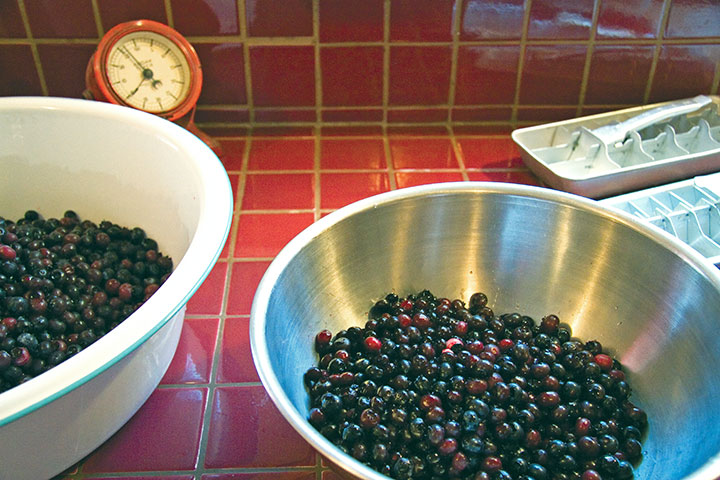
Here’s what the split berries look like; they should feel squishy, and you should be able to see the pale interior flesh on some of them. (Sorry about the photo quality—that red tile just kills the light.)
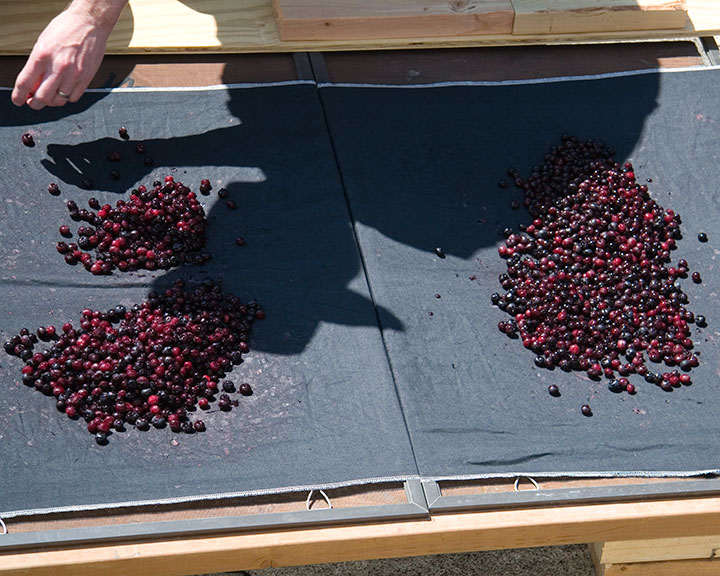
Okay, now you’re ready to take ’em outside. Distribute the berries evenly over the cloth-covered screens,

and spread them out until you have a single layer.

Now, just put the glass back into place, and let the sun do the work. It’s amazing how quickly the humidity inside the glass disappears, and how hot it gets in there. The ideal temperature for drying blueberries is about 140°F, but we’ve already seen our dryer get up to 155°. It doesn’t seem to hurt the final product, but at the hottest part of the day we cover the glass with a sheet for an hour or so, just to cool it down a bit.
About once a day it’s good to redistribute and un-stick the fruit, which helps it dry faster and more evenly. It takes about three full, sunny days to dry the berries completely—unlike raisins, you want blueberries to be so dry they rattle. You should end up with hard little husks that don’t squish and don’t stick together.
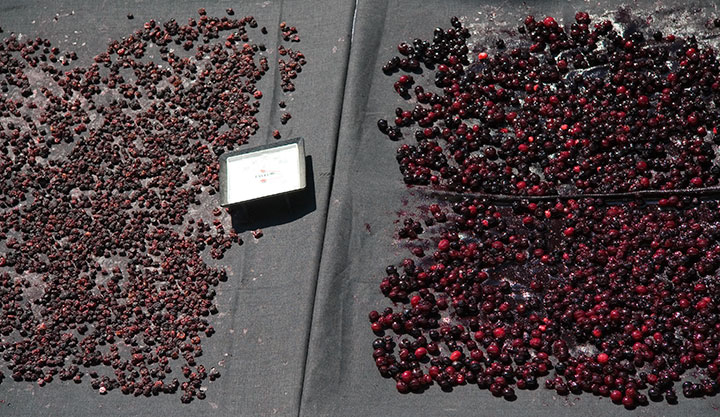
Here you can see the difference between fresh, split berries and ones that are almost done. Once they’re dry, pasteurize them for fifteen minutes in a 175° oven to kill any residual germs, and store in a sealed, air-tight jar.
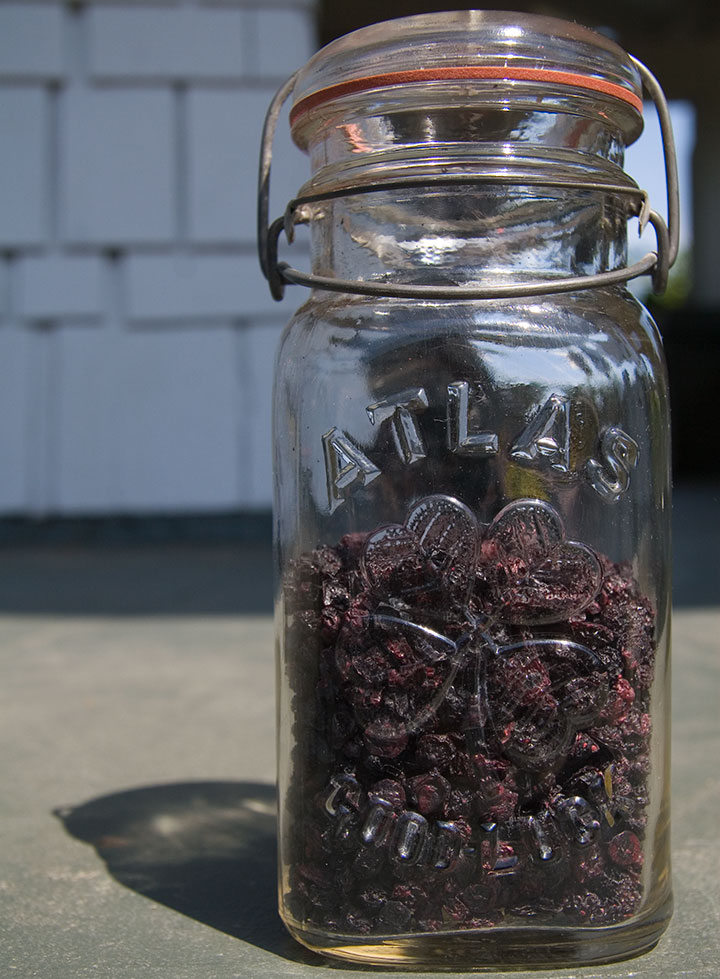
Since we’ll probably use our dried berries for a wide variety of recipes, we left them unsweetened. That way we can reconstitute them for pancakes, sauces and baked goods this winter without any recipe guesswork. They’re still sweet enough to eat plain, too (trail mix, anyone?), although if you prefer your berries pre-sweetened, you can coat them in simple syrup before drying.
Either way, you’ll end up with sunshine in a jar.
July 22nd, 2009
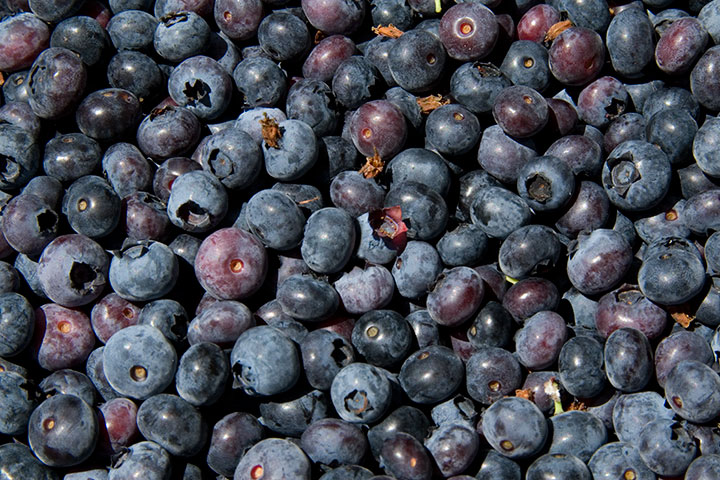
Maybe I’m still not over the shock of moving from Zone Two to Zone Eight, but the sheer variety of fresh produce ’round these parts never ceases to amaze me. Now, if I can barely contain my excitement over what I see at the farmer’s market every week, you can imagine the heart attack I had when the Tailor and I discovered Tacoma’s very own Blueberry Park.
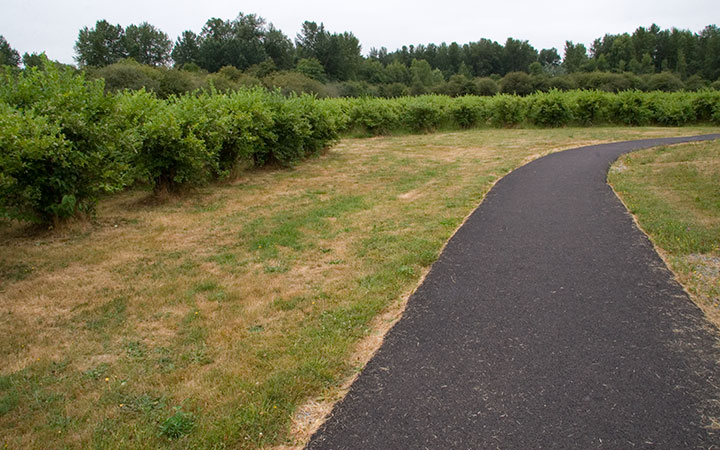
That’s right: a public park. Filled to the brim with blueberry bushes. Four thousand of them. Once upon a time this was a working blueberry farm—after the farm folded or moved on, the land sat vacant and overgrown for years. Eventually Metro Parks took over the land, and decided to free the sixty-year-old bushes from the bracken.
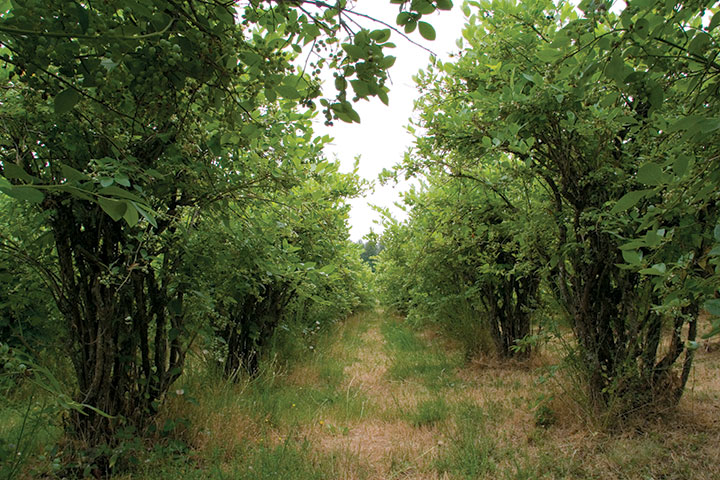
It took years of volunteer labor and many passes by a goat herd to hack back (or eat, depending on one’s preference) the scotch broom and blackberry vines. Now, though, the jungle is mostly kept at bay, and the result is an incredible bounty of pesticide-free berries. The best part? The pickin’ is free. Yes—all the fresh blueberries you, or I, or anyone and their maiden aunt can possibly pick, as many times as we like, for free. And with 4,000 bushes, there’s more than enough to go around. Talk about your tax dollars at work.
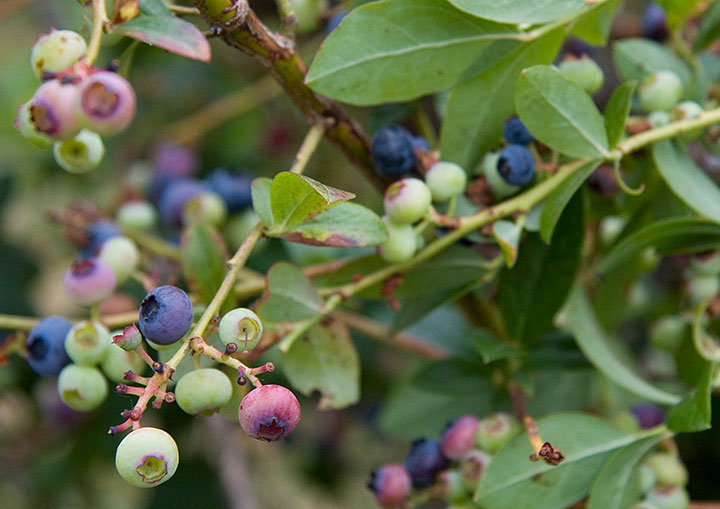
The Tailor and I woke up before the sun today for our third berry-picking session. Our two previous trips to Blueberry Park didn’t yield much, as we were a little early for blueberry season. Today, though, an impressive crop was ready to take home, so with metal pails in hand, we dove right in.
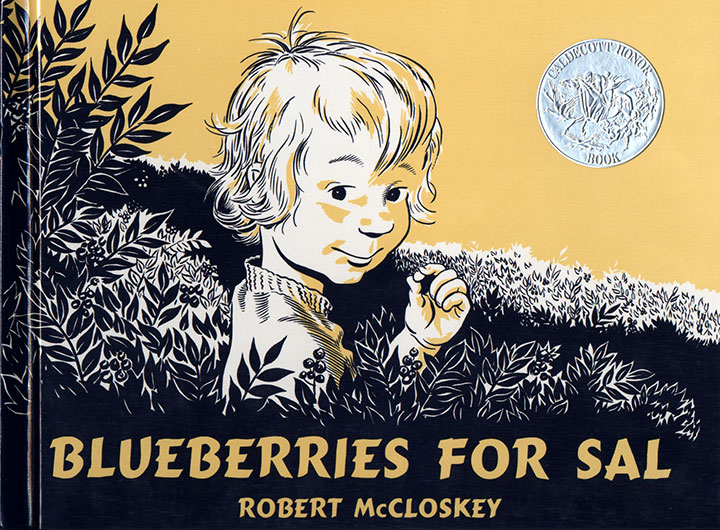
The sound of those first berries hitting the bottom of my pail—kerplink, kerplank, kerplunk—reminded me of one of my favorite children’s books of all time.
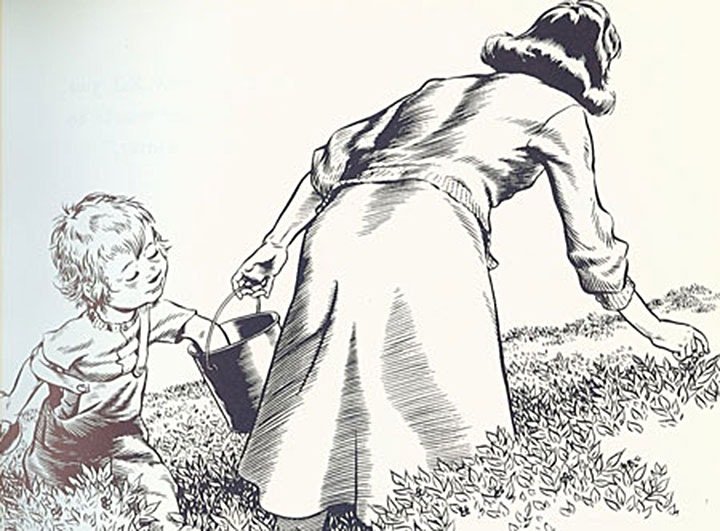
Since we had big plans for these berries, we made sure to arrive with a full stomach.
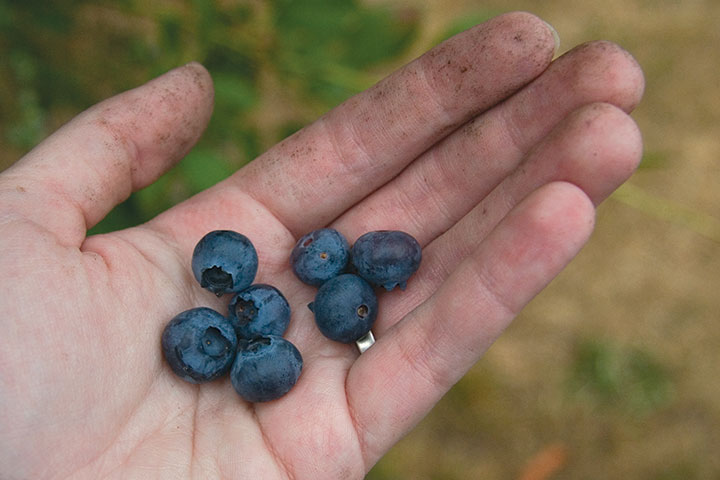
Well, alright, I did eat a few (even with my dirty hands).
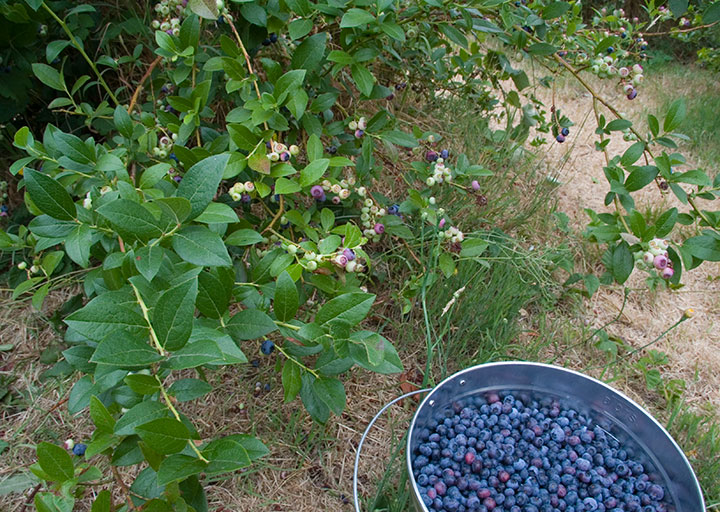
This is the yield of three hours’ work.
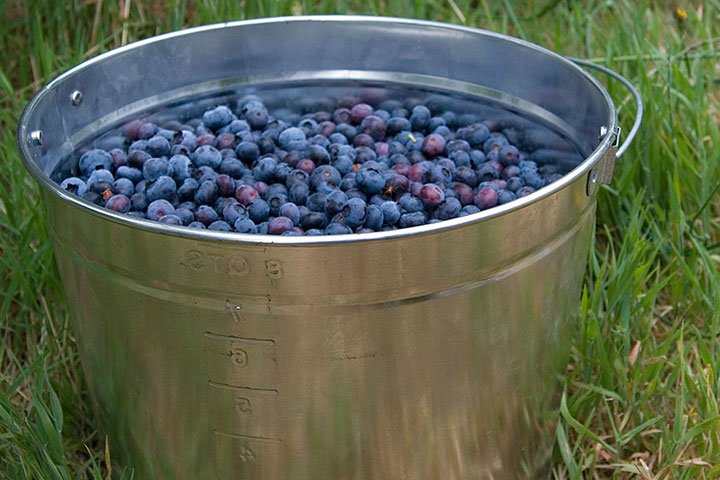
That’s a two-gallon bucket, mind you. We don’t mess around!
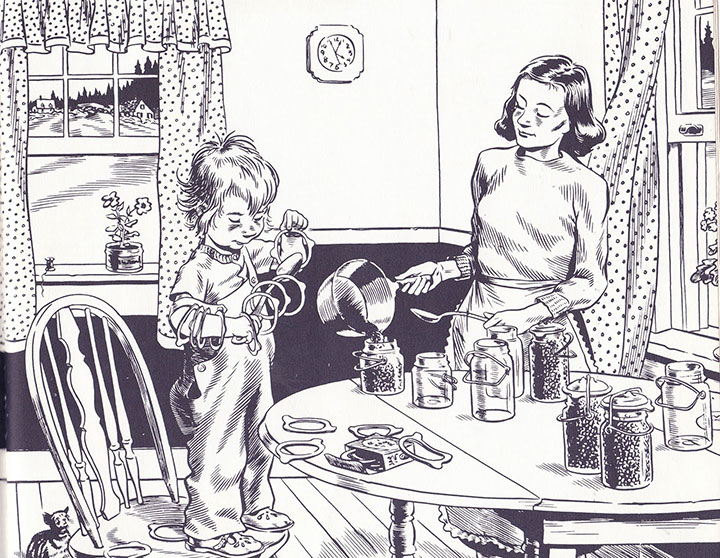
Our ultimate goal? The same as Sal’s mum: winter preserves. After all, if you’re a seasonal foodie, the only way to indulge a January craving for berries is to pop open one of your home-canned mason jars.
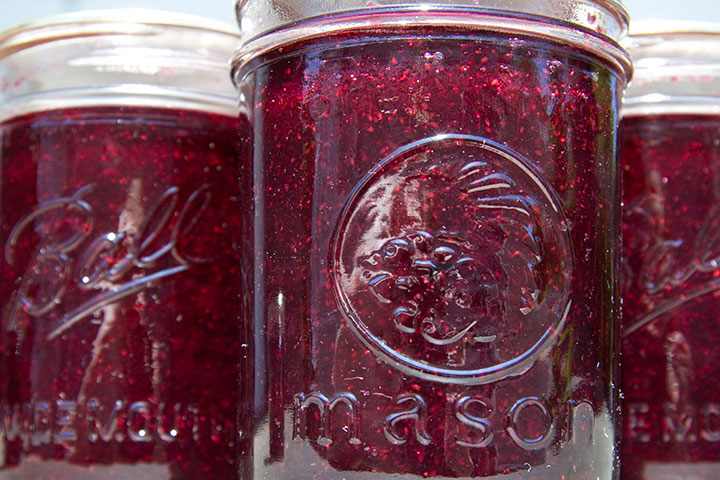
This sparkling jam, yielded by just four quarts of berries, is only the beginning.
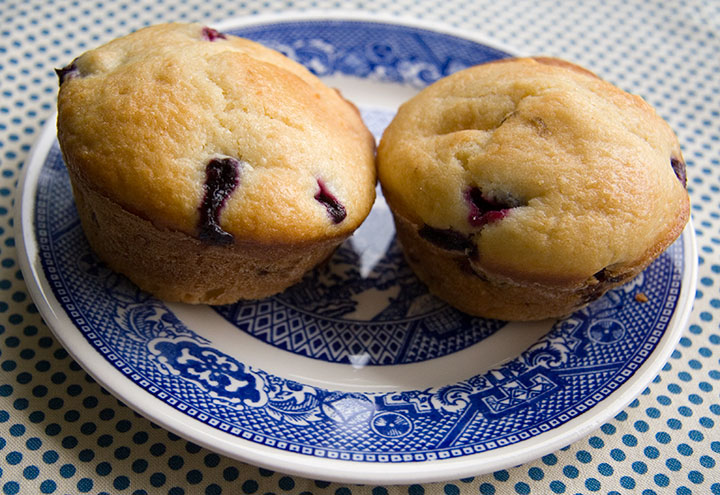
Our house is filled with the scent of baking and the excitement of so many possibilities—pies, pancakes, syrup, glazes, dried berries. What would you do with all the berries you can pick?
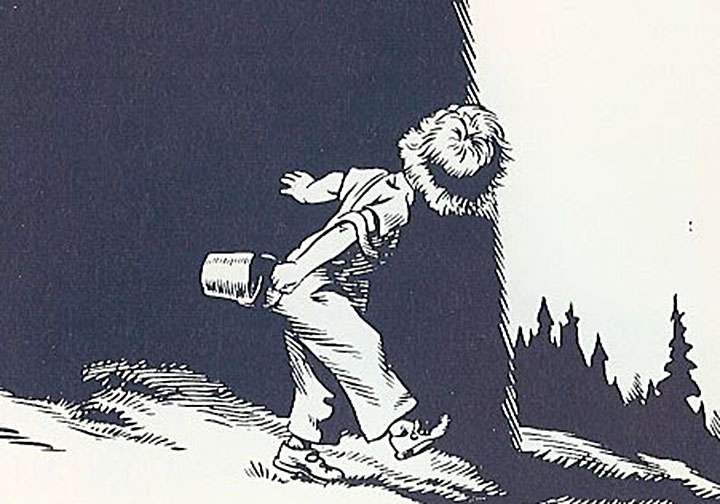
Grab a pail, head to south Tacoma, and find out.
July 20th, 2009
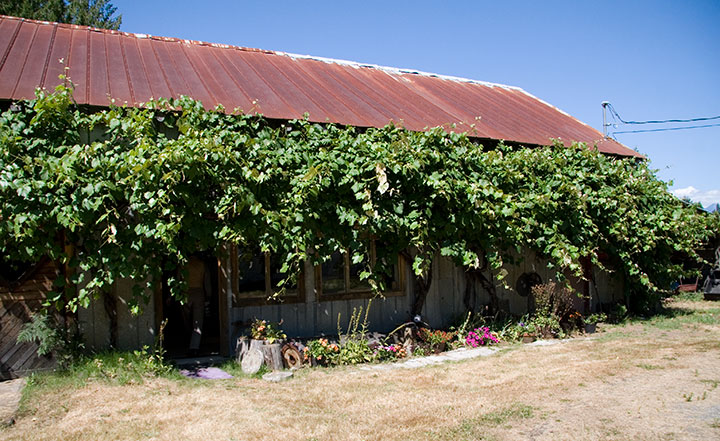
I serve on the board of the Book Arts Guild, a group that started as little gathering place for like-minded souls in the Pacific Northwest. It has since spiraled outward to include hundreds of members in all corners of the art form and the country—and suddenly thirty years have gone by. On Saturday fifty or so of us got together to celebrate the occasion at the Stern & Faye “Printing Farm” in the Skagit Valley.
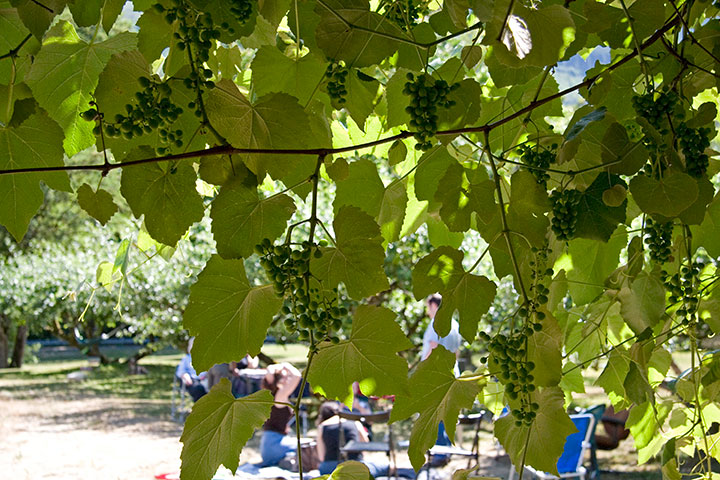
We couldn’t have asked for a better day—I could have stayed all afternoon in the orchard, chatting with kindred spirits.

I had heard so much about the studio, however—so while most of the group was drawing for prizes in the loft,
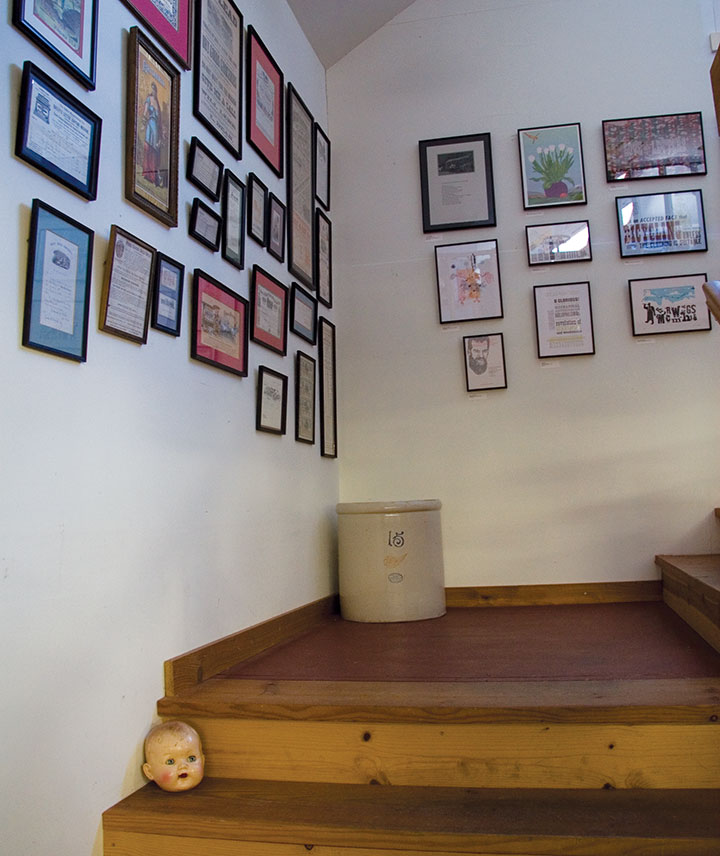
I wandered downstairs to do a bit of exploring.
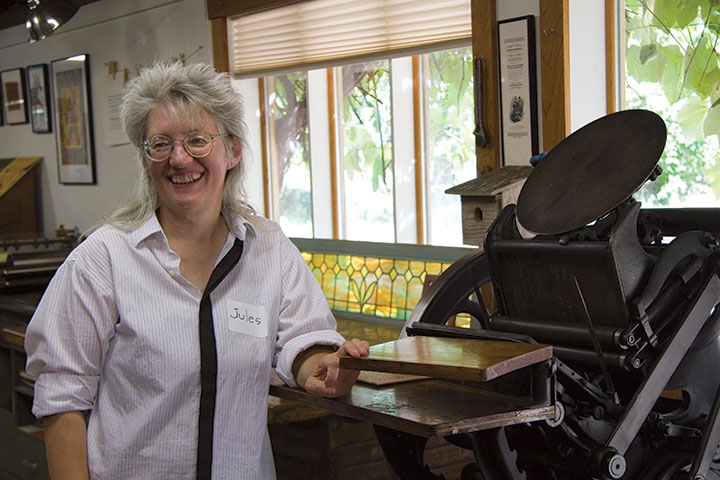
This is Jules Remedios Faye, “Proprietrix” of the Farm. She and her husband, Chris Stern, moved to the Skagit Valley fourteen years ago and turned an old barn into a letterpress printer’s dream.

The space is at once cozy and seemingly never-ending,

serving as both a working studio and a living relic.
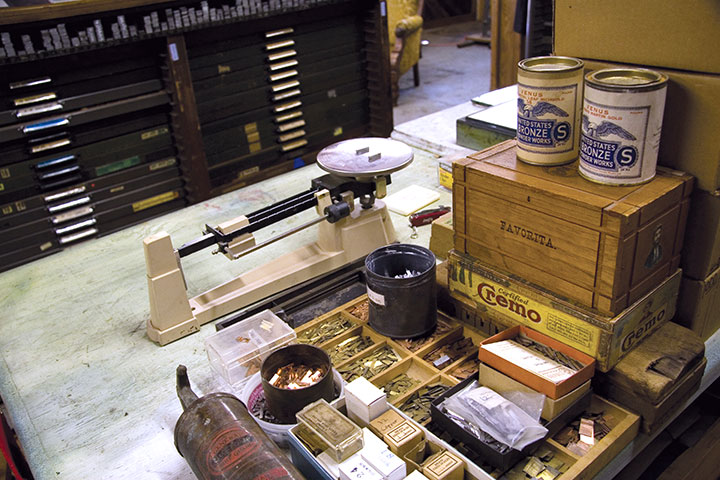
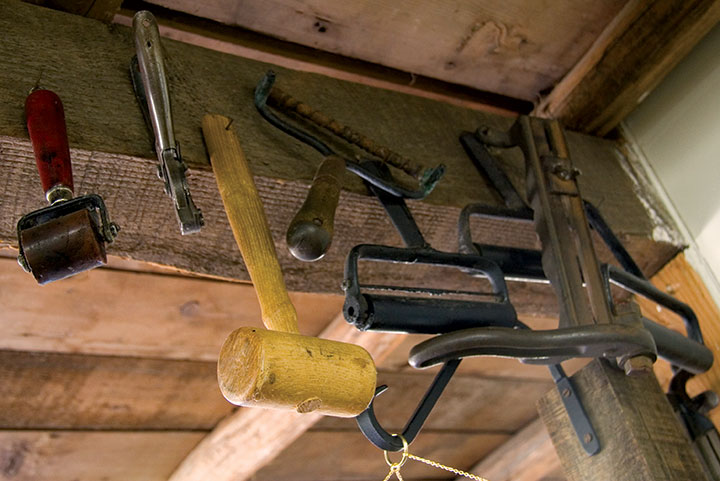
The place is chock-a-block with tools, type and ephemera, and functions as a type foundry as well—one of a small and dwindling number remaining in the U.S. these days.

After Chris passed away in 2006, Jules was forced to scale back the studio a bit to continue managing it alone. The barn is still very much alive, though—the walls are festooned with prints, and evidence of well-loved and continuing use is all around. It feels like their space, not just hers.
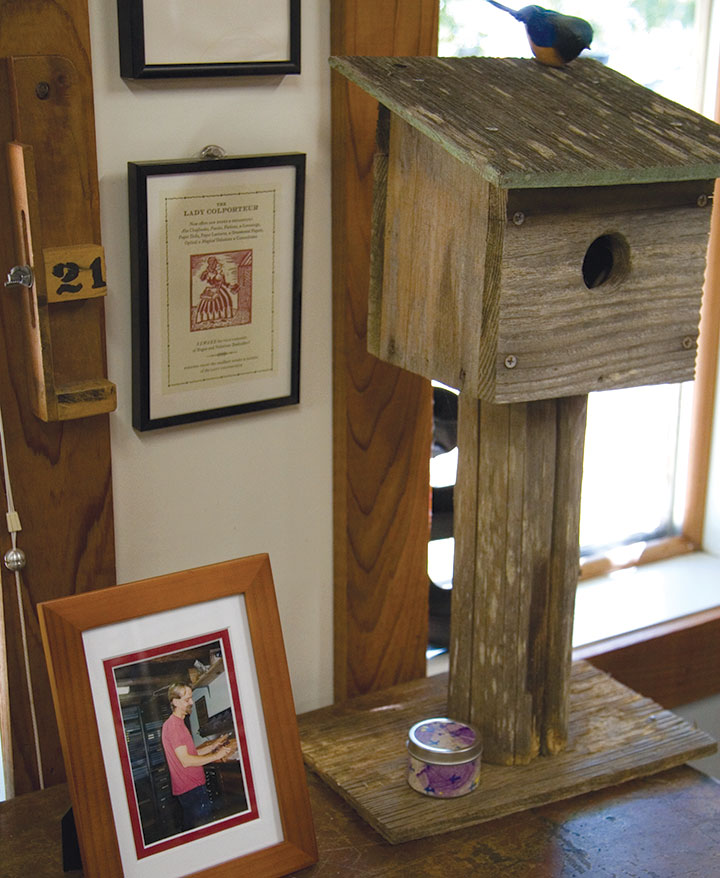
His presence is everywhere—a fitting memorial.
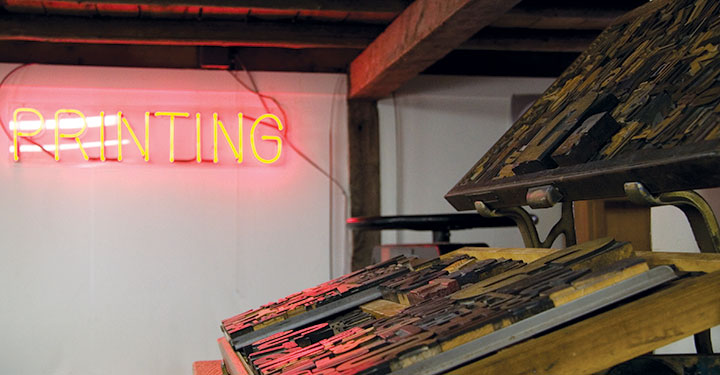
The Printing Farm was the absolute best-possible place to celebrate the anniversary of the Book Arts Guild. It served as a touching reminder that no matter how far into the past our roots go, no matter who has gone before us or what new trends have appeared, we’re still here—still breathing, still practicing, still creating.
After all, that’s what we’re here for.
July 13th, 2009
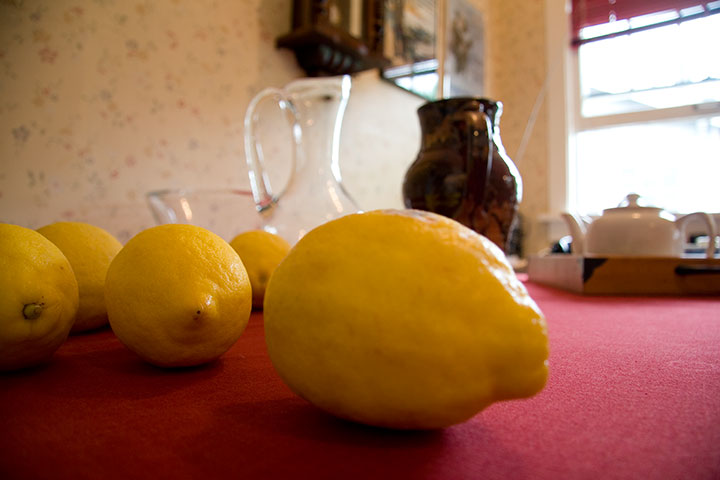
First, invite your family down for the day. Squeeze out some fresh lemonade;
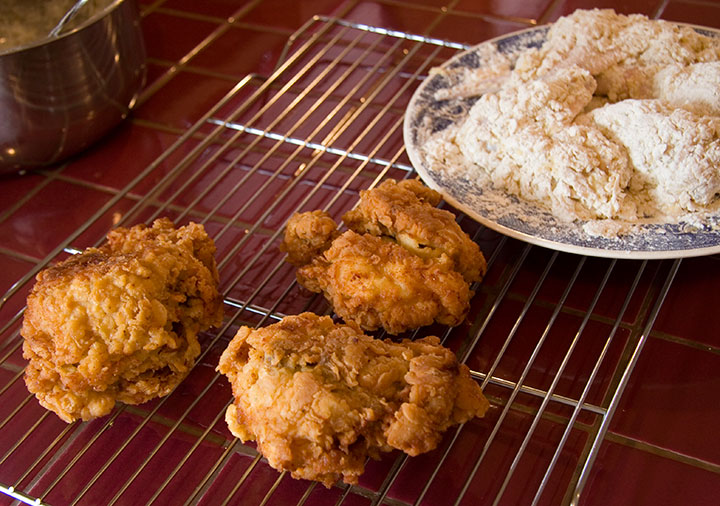
and fry up a free-range chicken.

Then mix up some cream, sugar, and fresh berries (plus just a pinch of that lemon juice to bring out the flavor);
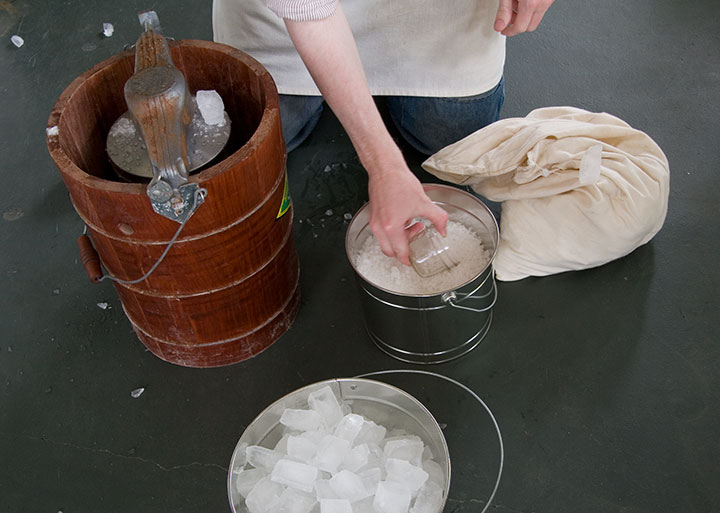
pack ice and salt around it;
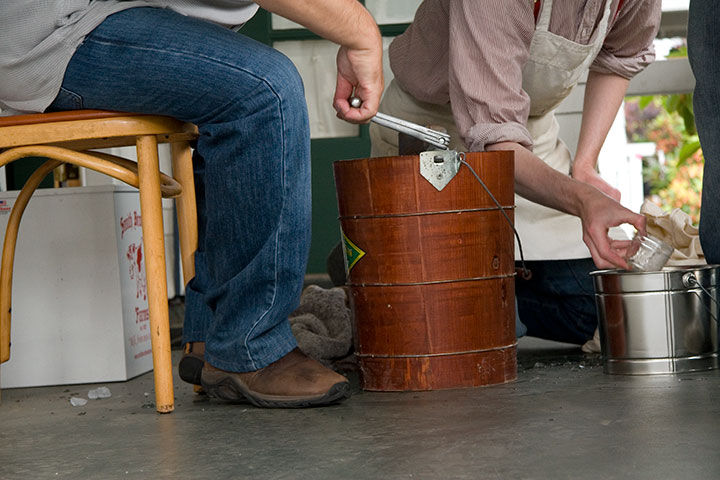
and start crankin’.
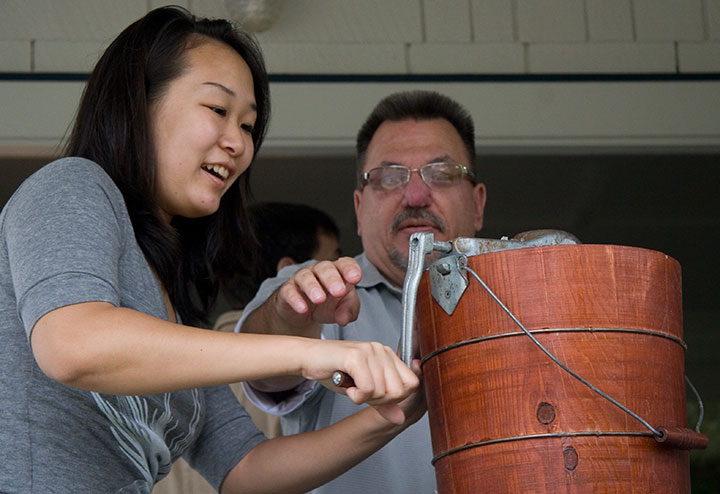
Let everyone pitch in—the longer you churn, the harder it’ll get.
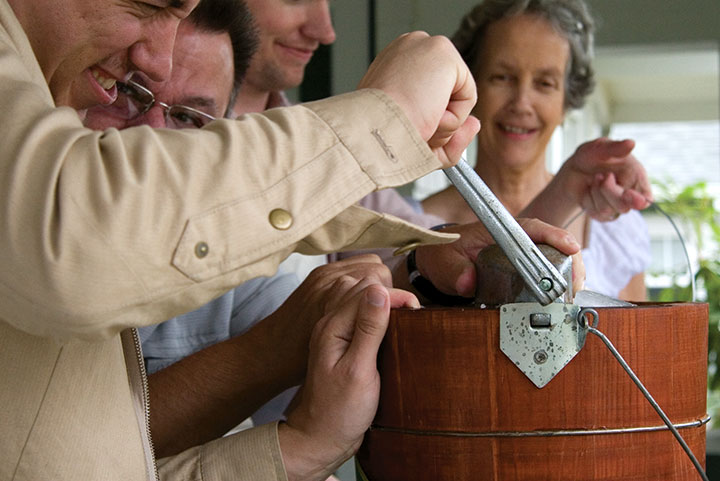
Finally, when even teamwork won’t turn that handle, you’re ready.
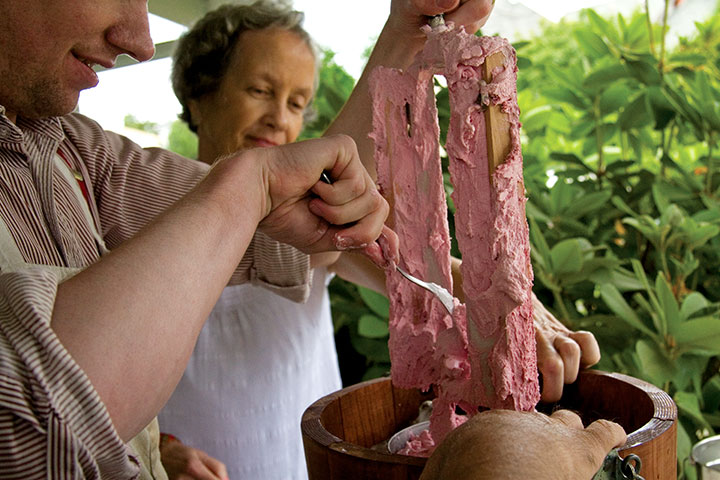
And hey, presto—
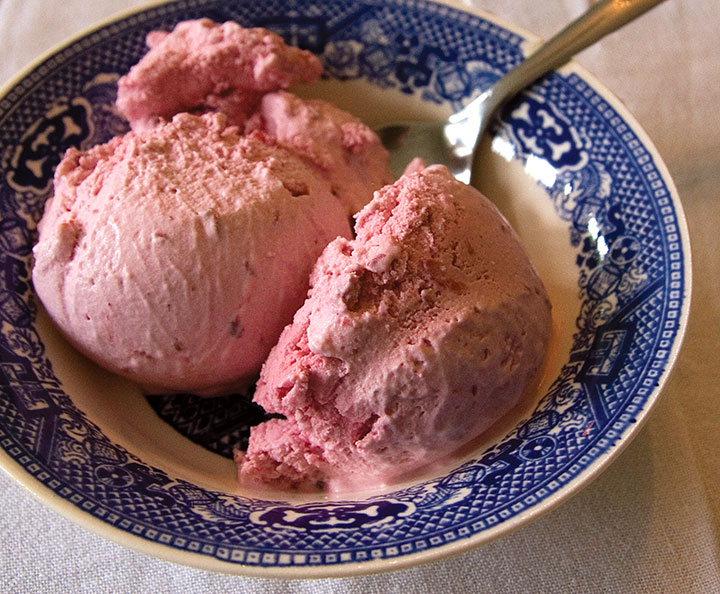
summer in a bowl.
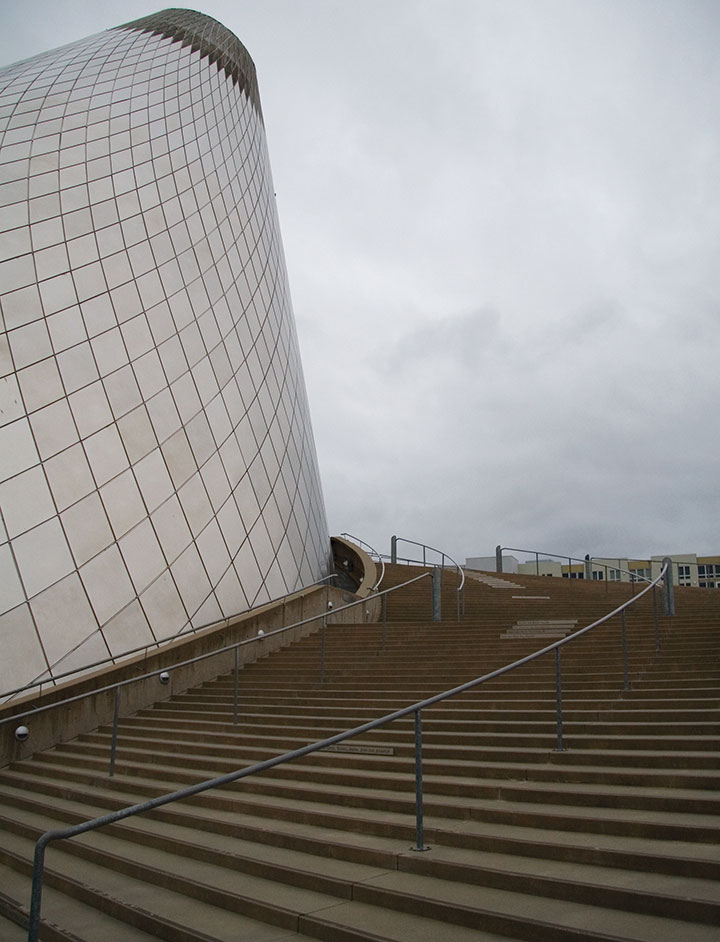
If all that ice cream gives you a chill, just head for the hot shop;

gather around the fire;
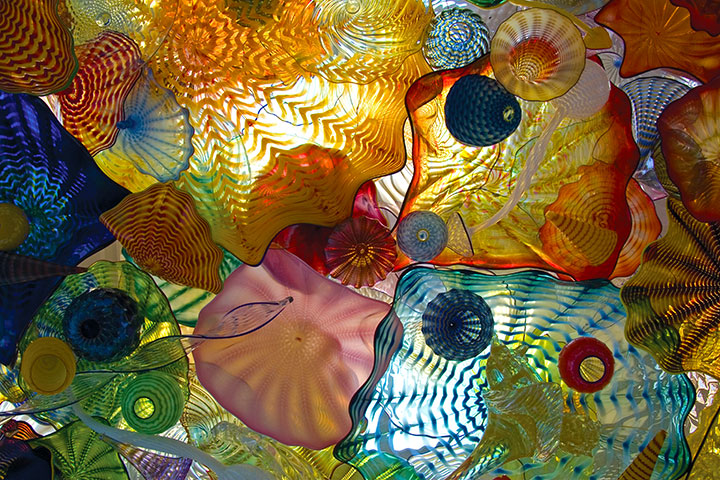
and bask in the perfect day you made.
July 6th, 2009
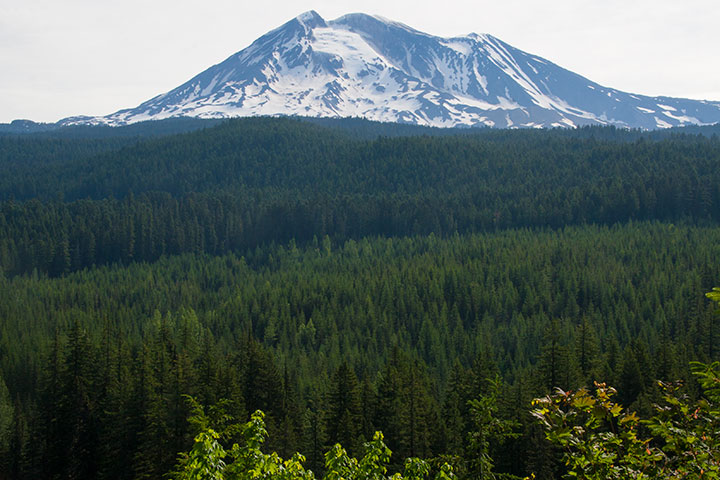
In my (so far) limited experience, Washingtonians tend to be outdoor types—and with good reason. With so much beauty at our fingertips, it’s no wonder that with the first hint of a sunny day, we’re out in force. Add to that the near-clockwork arrival of the dry season by Independence Day, and the fact that huge swaths of the mountains are inaccessible for nine months out of the year—well, you can see where I’m going with this. Since the Fourth of July was kind enough to fall on a Saturday this year, the cities emptied and thousands headed Outward. And this year, though we’re normally Off-Season, Off-the-Beaten-Path types, the Tailor and I were no exception. Like zombies we staggered outdoors to pack our tiny Subaru sedan—must … go … camping!
We knew it was probably folly, but we had a goal in mind: find a beautiful, mountainous campsite away from the teeming hordes. We knew Mount Rainier would be out of the question, as were the Olympic Peninsula, Mount St. Helens, or any other popular tourist destinations—but even though we had a head start by leaving on Thursday afternoon, our hope faded as we saw the crush of fellow vacationers on the freeway. “Camper … camper … RV … canoe … RV … kayaks … cyclists … camper,” the Tailor droned, counting cars, “this was a dumb idea.” Yet as our route took us on smaller and smaller roads, the number of fellow travelers dwindled almost to none. It began to seem like our instincts were right after all.
Our destination? The Morrison Creek Campground, located on the southern slope of Mount Adams, Rainier’s slightly-smaller, lesser-known brother.
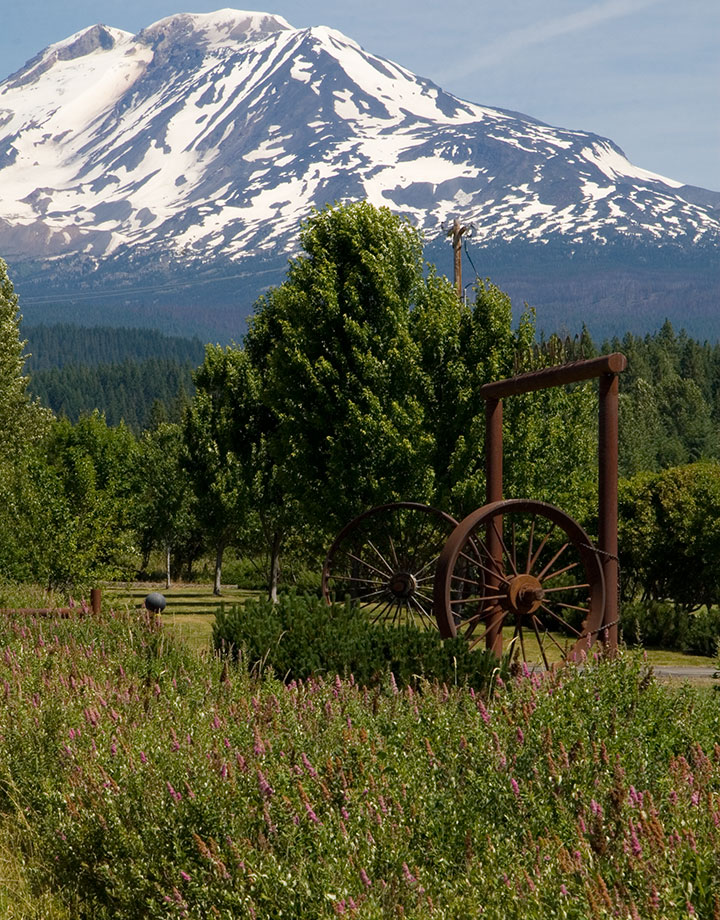
While we were nervous of the possibility of any volcano attracting busloads of holiday tourists, our choice had a couple of points in our favor. For one thing, one can’t reserve a campsite in a national forest; all sites are taken on a first-come, first-served basis. For another, Morrison Creek is in the middle of freakin’ nowhere.
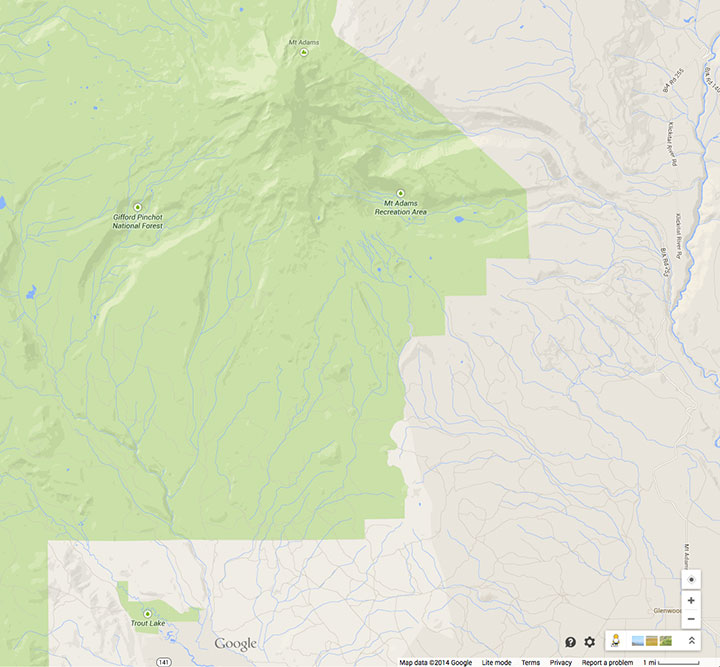
The only way to get there from the north is to use the system of Forest Service roads that wind through the Gifford-Pinchot National Forest. The paved sections are breathtakingly beautiful and super fun to drive (especially with a stick shift; I felt like I was filming a car commercial). The “unimproved” stretches, on the other hand, range from challenging to terrifying. Mindful of the consequences of puncturing an oil pan or snapping an axle on a holiday weekend in one of the most remote pockets of the state, I took my sweet time picking my way around the detritus of recent rock slides and dodging monstrous potholes.
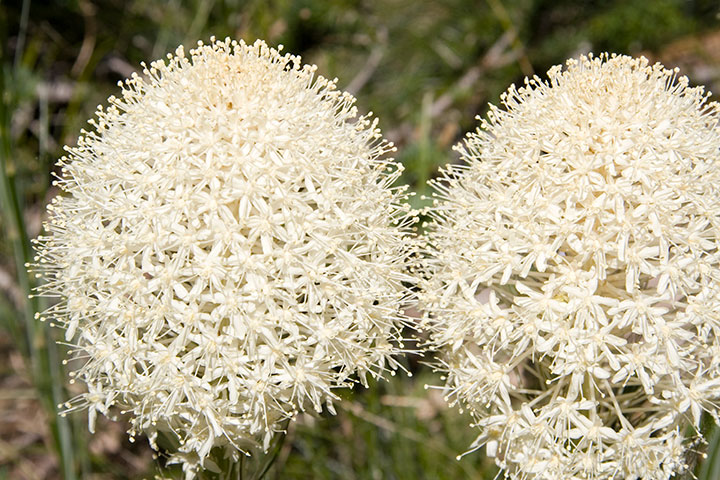
When we pitched our tent just as the last light faded, however, we knew that it was absolutely worth the trip. Our campsite was in a lovely, secluded spot, adjacent to the Creek, just below the last traces of mountain snow, and surrounded by pockets of blooming beargrass. And to our immense surprise, we had Adams almost entirely to ourselves, for the whole weekend—funny, considering that the next campground, three miles up the road, was crawling with mountain climbers.
I was hoping our travels would afford us at least one view of Rainier in the distance—that way I’d have another sketch to add to my store of potential artist book imagery. FS Route 23, however, doesn’t afford such a vista, and any potential viewpoint reached by hiking trail was well out of range of our abilities. A two-mile hike from our tent did give us a spectacular, alpine-meadow view of Adams, though—and I realized that for my research purposes, I could use the peak as a sort of stunt double.
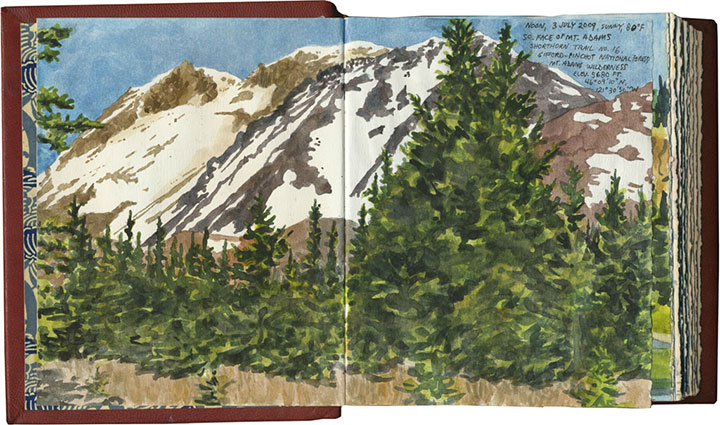
From certain angles, Adams is remarkably similar to Rainier (and people often mistake one for the another when viewed from a distance). All the more reason to use my time there for drawing. I was surprised to see, however, how drastically Adams’ appearance changed, depending on the vantage point. This is the view from Bird Lake, on Yakama Nation land, just a couple of miles (as the crow flies) east of Morrison Creek:
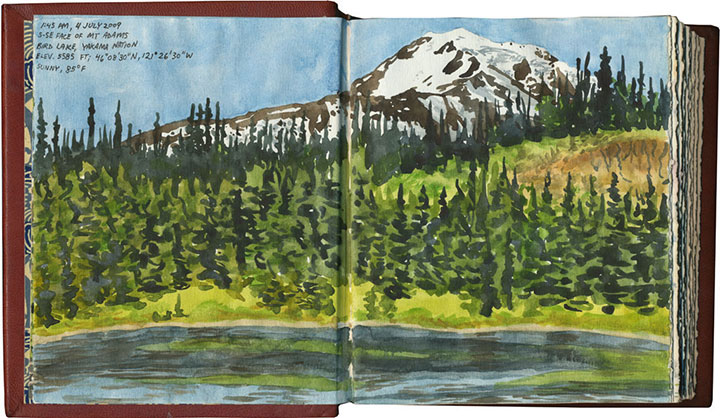
And though there was nowhere to sit to capture it in my sketchbook, a gap in the trees gave me the chance to glimpse another stand-in to the south: Mount Hood.
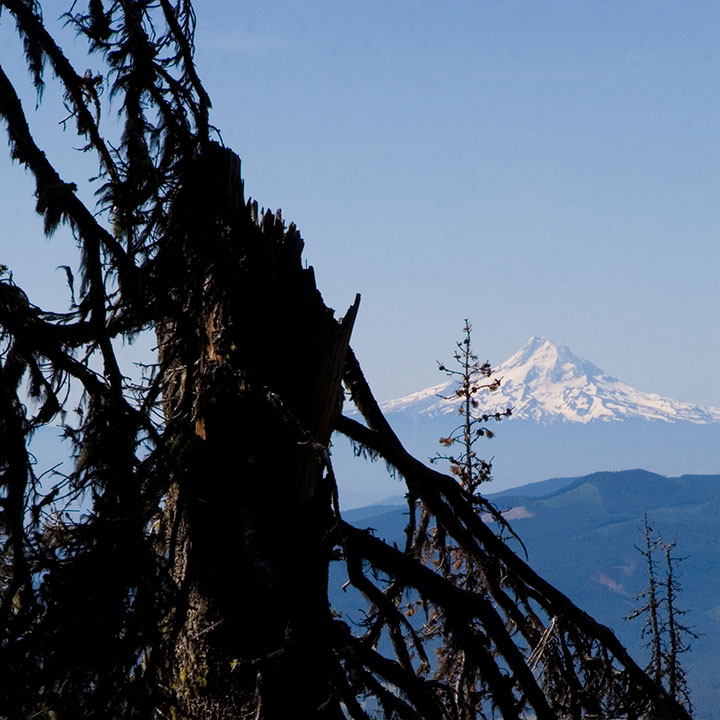
What an incredible weekend. As you can probably guess, Adams is on the short list for Best Camping Spots Ever, and I’m sure we’ll end up returning again and again. Next time, though, it might behoove us to reconsider our mode of transportation; it’s doable in a compact car (just barely), but I think I’d rather rent a pickup truck—or a mountain goat.
June 30th, 2009
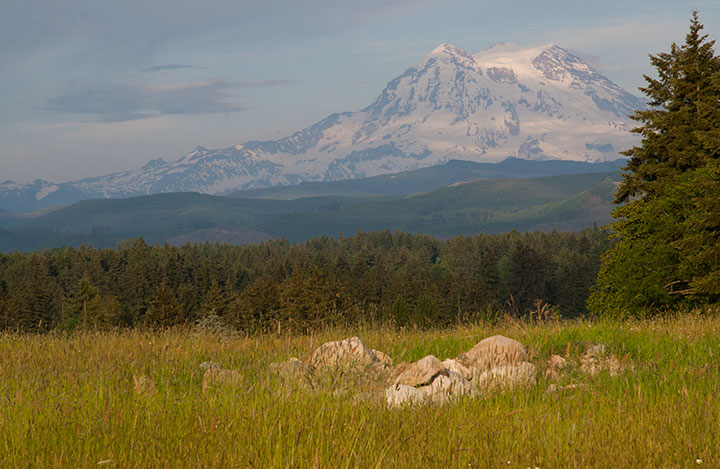
A few months ago I was granted funding by the City of Tacoma Arts Commission to create my next artist book edition. Since this is the first of what will probably be a long string of posts over the next eighteen months, I’ll save the details for later. For now, I’ll just say that the book deals with the changing appearance (and intrinsic nature, since it’s an active volcano) of Mt. Rainier. At the moment I’m knee-deep in research, trying to capture the Mountain in as many different—well, attitudes, as Jane Austen would put it—as possible.
The Tailor and I spent last week visiting old friends and haunts in Minneapolis, and as luck would have it, I had the window seat on the south side of the plane on our flight out. I had my paints, brush, and film canister full of water ready as we taxied, so that when we cleared the cloud ceiling I had a solid two minutes or so for a sketchbook snapshot.
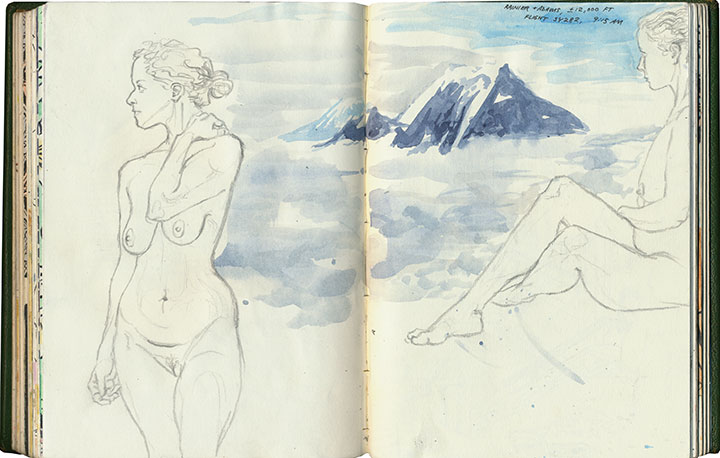
It occurred to me, though, that while a 120-second gesture painting (complete with frantic paint spatter) would be a nice addition to the sketchbook, it wouldn’t provide nearly enough reliable detail to serve as the basis for a future letterpress print. So on the way back, I requested another window seat (I think the fact that I’d sprained my ankle on our last day of the trip, and had to hobble to the counter, might have helped my case a bit) so as to document any Mountain sightings with the camera.
The counter attendant had been kind enough to place me on the correct side of the plane again. And the weather was crystal-clear, affording the passengers with stunning, morning-lit views of Rainier and the entire Cascade volcano chain. The cabin was filled with sounds of hushed awe and clicking shutters. There was only one snag in my research scheme—Row Nine, in which we were seated, seemed to use the term “window seat” loosely.
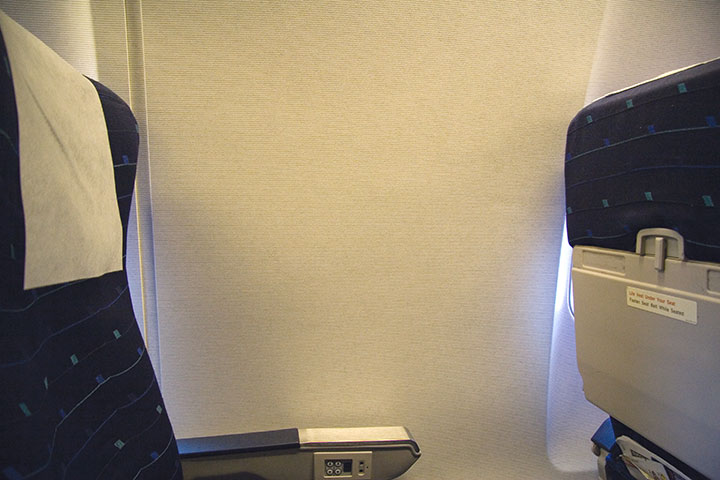
And the universe kept right on laughing.
June 21st, 2009
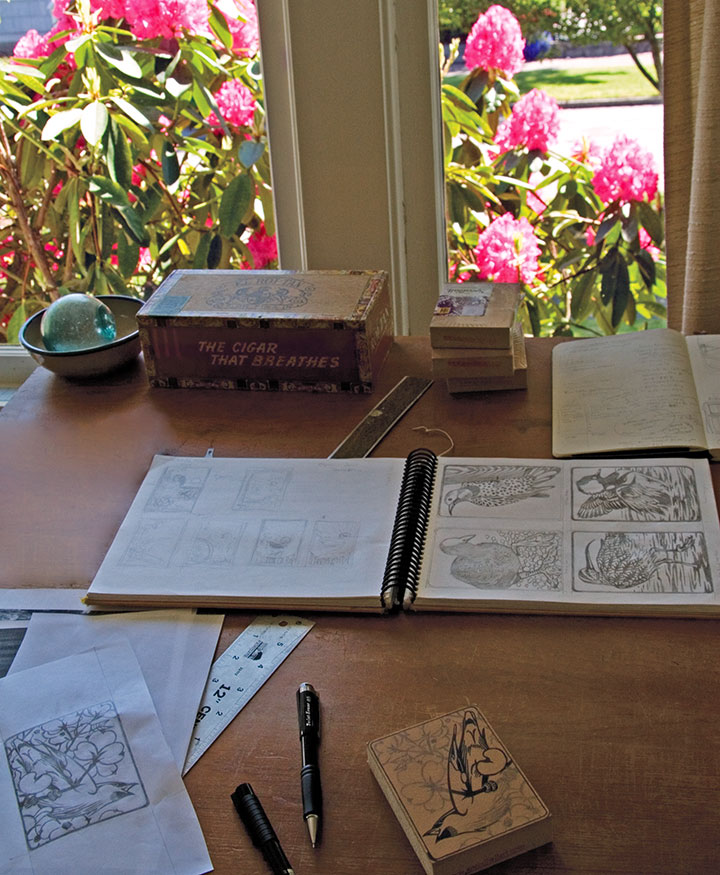
There’s some serious gear-shifting going on in the studio these days. Prop Cake and Tugboat Thea are sold out, and the Woolworth Windows murals are white walls again, ready for the next artist to transform the space. I’m preparing to teach a letterpress class at the School of Visual Concepts next month, and I’m working on a new artist book (more on that topic later). I feel like I’m in that tiny, transitional moment between exhale and inhale.
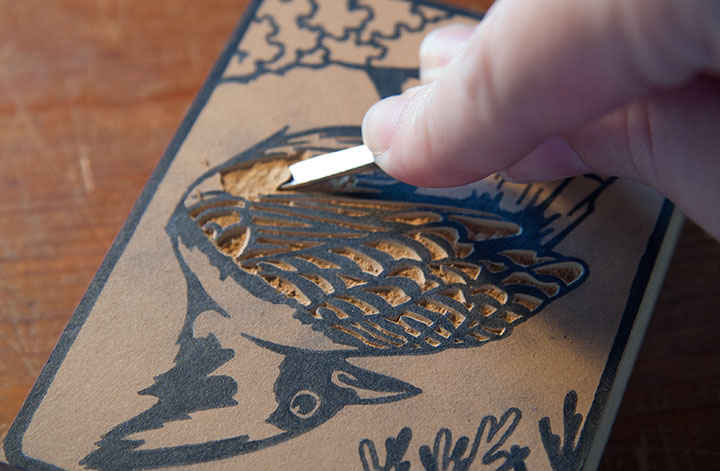
So what better way to use that breath of time than to slow down and do some carving?
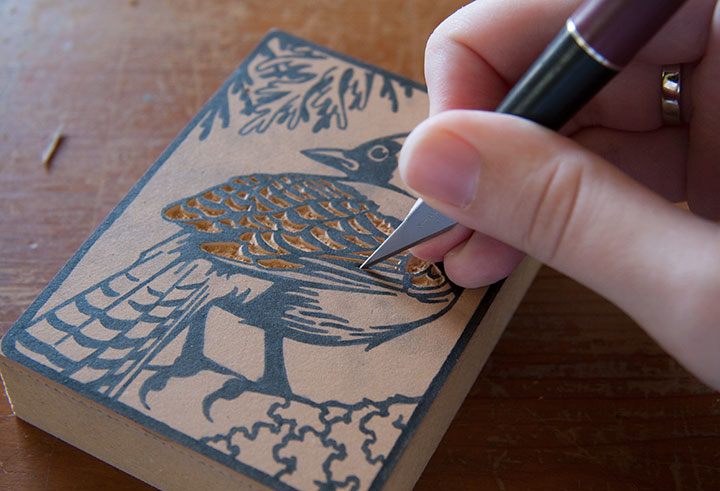
In the free moments between my other projects, I’m also working on a new print series that’s got me all a-flutter.
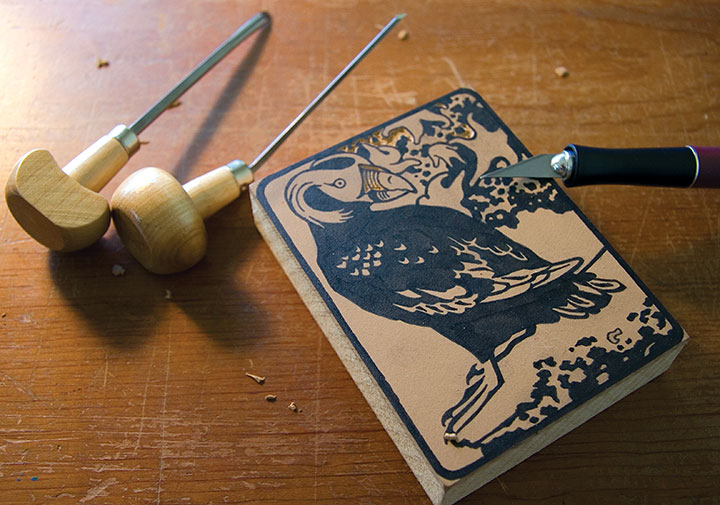
I love getting back to basics, and enjoying the simple mechanics of drawing, carving, and printing images. No fancy photopolymer plates this time—just ink, paper, watercolor, and good old-fashioned linoleum blocks.
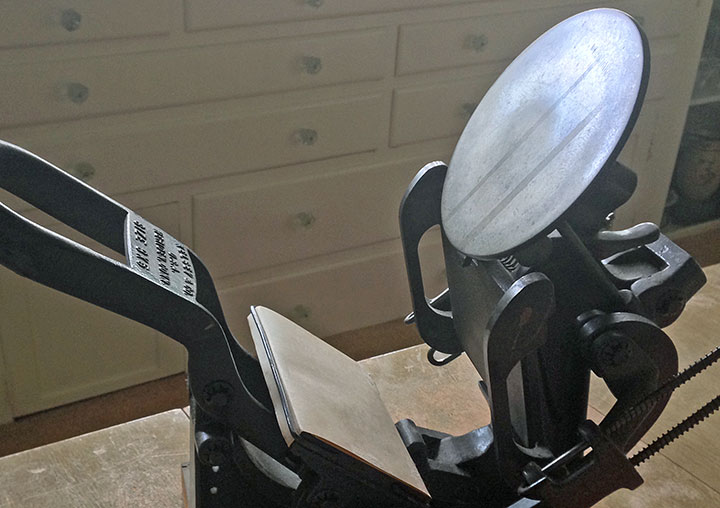
What started as an excuse to get my little Kelsey tabletop press in working order—
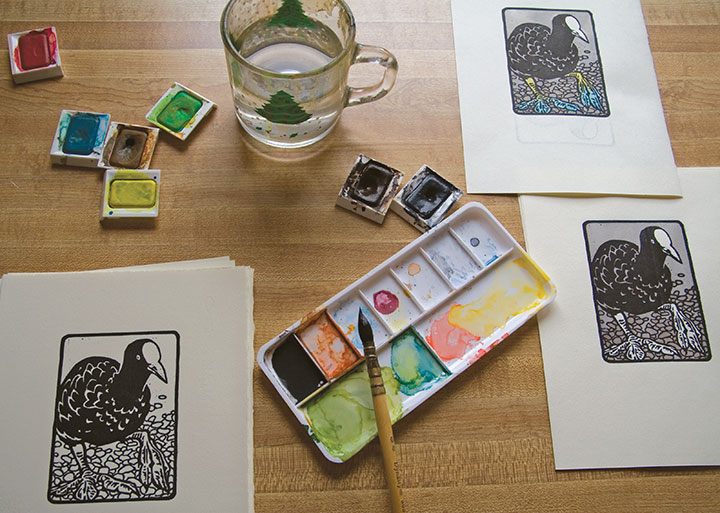
—has turned into a budding interest in birding. There is a stunning array of avian wildlife in my state, and I’m only creating a tiny illustrated cross-section of what’s out there.

The suite tweet of prints is called Flock, and the first nine are currently on display at the Rosewood Café in Tacoma until July 31.
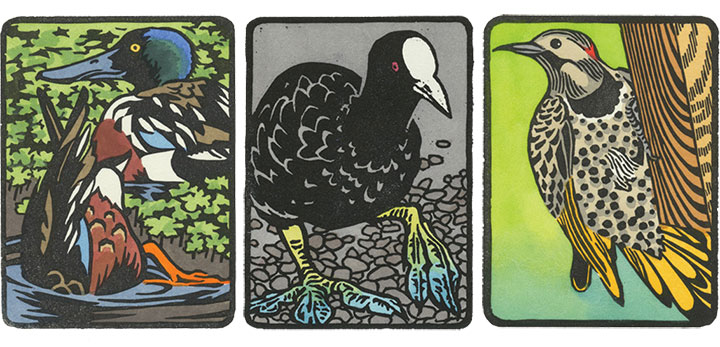
Here’s a closer look at ’em.
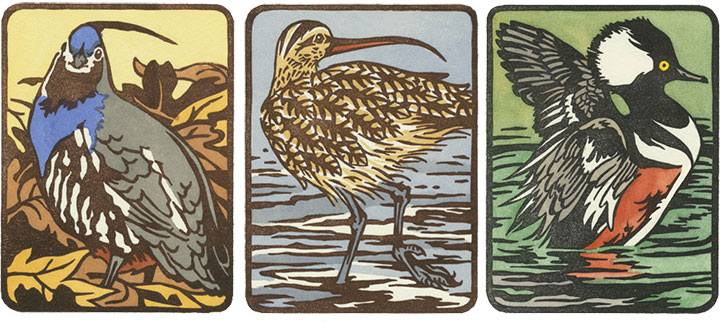
Each print is a hand-colored linocut, printed in an edition of 25. There will be 25 birds in all, and at the end of the series, there will be ten handmade boxed sets—each containing all 25 birds.
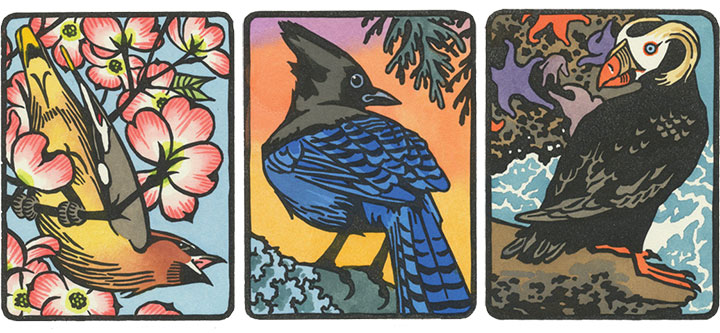
I’ll be printing the rest of the birds in the coming months, and the Flock box sets will be finished sometime next year—eight of the ten sets are spoken for already, but if you’re interested, feel free to drop me a line. I’ll just be here in the studio, happily chirping, cawing, quacking, and twittering away.
June 19th, 2009
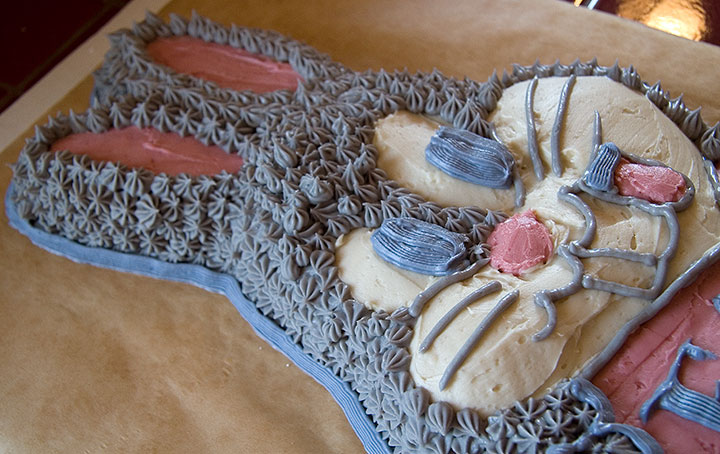
What with a string of out-of-town visitors and deadlines to distract us, the Tailor and I let our first anniversary slide by without much fanfare. This week, however, we remembered the nostalgic, circa-early-1980s, licensed-character Wilton cake pans we borrowed from his parents last winter, and decided a belated, totally un-wedding-like anniversary cake was in order. (Sane people just go out for a nice dinner.)
When I was a kid I loved the weird, hairy-looking frosting on those Cookie Monster and Pac Man cakes, but I don’t remember actually having one at any of my birthdays (I usually requested pumpkin pie, still my favorite). So this was my chance to both relive and rewrite my childhood—and to try my hand at creating that bizarre, strangely satisfying frosting texture.
The Tailor found a white cake recipe in our favorite cook book (we have three copies!), and we modified an icing recipe to include only butter, sugar, vanilla and cream (about the only thing you’ll ever see me using shortening for is cleaning letterpress equipment). Then I noticed that the cake mold left room to write a message in icing—and my eyes strayed to my decorating tip, which was shaped curiously like a calligraphy pen nib. So I couldn’t resist attempting a little edible typography. The cake wasn’t large enough to write “Happy Anniversary” with any typographic flair—and that’s not my style anyway. So I went with something a little more down-to-earth, and, well, appropriate to the medium:
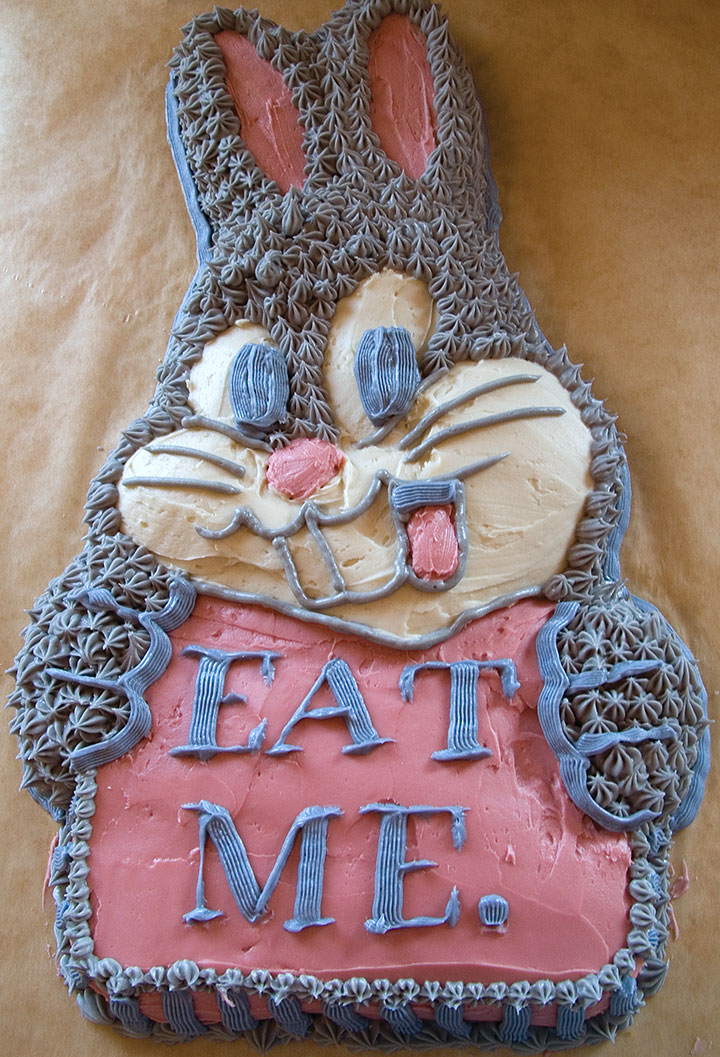
(We did. Most joyfully. My edible kerning needs some work, though…)
















![Chandler O'Leary [logo]](https://chandleroleary.com/wp-content/themes/chandleroleary/images/logo.png)





































































